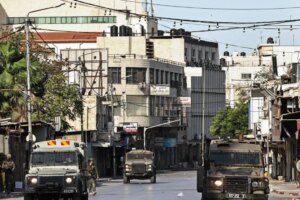
This is the second of a four-part series. Part one is published here.
The Crimes of Stalinism and the Rise of Pan-Africanism
Isolated by the defeats suffered by the European working class, the Soviet Union became increasingly dominated by a conservative bureaucratic caste under Joseph Stalin. This bureaucracy gradually usurped political power from the working class, betraying the revolutionary internationalism that had guided the October Revolution and the Comintern. In place of the global strategy of Permanent Revolution advanced by Lenin and Trotsky, Stalin promulgated the reactionary nationalist doctrine of “Socialism in One Country,” severing the fate of the Soviet workers’ state from the worldwide struggle for socialism.
Stalin’s programme meant the subordination of the international working class to the narrow, nationalist interests of the Soviet bureaucracy, which was preoccupied with safeguarding its own privileges. Through its influence over the Communist parties of the Comintern, Stalinism sowed confusion and disorientation within the workers’ movement, leading to a series of historic defeats.
Joseph Stalin in 1943 [AP Photo]
In China, Stalin forced the Chinese Communist Party into the bourgeois nationalist Kuomintang, insisting on a “bloc of four classes” that included the national bourgeoisie during the Second Chinese Revolution of 1925-1927. Trotsky warned that this would disarm the working class, and the 1927 Shanghai massacre of tens of thousands of communists by the Kuomintang vindicated his warnings.
In South Africa, the Comintern imposed the “Native Republic” thesis on the Communist Party of South Africa (CPSA), demanding a capitalist stage under a black bourgeoisie before socialism. This subordinated the party to the African National Congress and bound the working class to bourgeois nationalism. It became the basis for the CPSA’s long-running alliance with the ANC, a partnership that continues today as they preside over one of the most unequal societies in the world.
Trotsky opposed this two-stage strategy. In his “Letter to South African Revolutionaries”, he rejected policies that subordinated workers to bourgeois nationalism and warned that Marxism must base itself on the independent mobilisation of African workers. He insisted that the party “must champion with all its strength the complete and unconditional right of the blacks to independence,” but emphasised that “only the proletariat, leading the native masses,” could resolve the national and agrarian questions, which pointed directly toward the struggle for a workers’ state rather than a bourgeois stage.
In Germany, the Communist Party refused to form a united front with the Social Democrats against the Nazis, even though until 1932 the combined workers’ organisations were numerically—and, due to their base in the working class, socially—far stronger than Hitler. This sectarian line helped clear the path for the Nazi takeover in 1933. The Soviet bureaucracy then swung to the opposite extreme, ordering Communist parties to form popular fronts with liberal bourgeois forces and abandon any struggle in the colonies so as not to jeopardise Moscow’s diplomatic manoeuvres with imperialism.
Soon after, the British and French sections abandoned agitation for colonial independence, in the name of “anti-fascism” and “defending democracy.” The absurdity of this line was clear in Portugal, where the Communist Party, operating clandestinely under the fascist Estado Novo dictatorship, avoided advocating independence for Angola or Mozambique. By subordinating colonial liberation to the diplomatic interests of imperial powers, Stalinism discredited socialism in the colonies.
When General Francisco Franco launched his fascist coup in 1936 and sparked a three-year civil war, his most decisive forces comprised 80,000 Moroccan colonial troops. But the Popular Front government, dominated by the Stalinists, refused to proclaim Moroccan independence from Spain. As the Trotskyists insisted, a revolutionary appeal to the Moroccan masses could have shattered Franco’s base and opened a joint struggle of Spanish workers and the colonised against imperialism. Instead, Stalin suppressed any such action for fear of upsetting Britain and France, helping seal the defeat of the Spanish Revolution.
Stalin launched the Great Purges of the 1930s, physically exterminating the finest representatives of generations of Marxist intellectuals, that would culminate in the murder of Trotsky in Mexico in 1940 by a GPU agent. In the Soviet Union, close to one million people were executed in this counterrevolutionary violence between 1936 and 1939. Across the Comintern, countless militants who had once fought for the October Revolution and pioneers in the founding of Communist Parties in their respective countries were eliminated. Albert Nzula, the CPSA’s first black Secretary General was killed after showing sympathy for Trotsky and voicing criticisms of Stalin.[1]
The Stalinist counterrevolution disoriented millions of left-wing workers. With Trotskyism suppressed inside the Soviet Union and persecuted across Europe, the emerging African working class was left without the revolutionary internationalist perspective necessary to lead the struggle against imperialism.
In this vacuum, a new current began to take shape: Pan Africanism. Its most influential architect, George Padmore, had risen within the Stalinist apparatus. As a trusted Comintern official in Moscow, he had participated in disciplinary commissions tasked with policing ideological loyalty and rooting out alleged “Trotskyists” within the Chinese Communist Party and other sections.
George Padmore [Photo: http://farm3.static.flickr.com/2748/4108837693_337f687912.jpg ]
Padmore only broke with the Soviet Bureaucracy in 1934 when it became clear that Stalin had abandoned any genuine interest in anti-colonial struggles and viewed the nationalist movements in Africa, as elsewhere, as bargaining chips in his diplomatic maneuvers with the imperialist powers. His ideas, however, remained firmly rooted in a Stalinist nationalist outlook.
Padmore’s role was only enhanced after the catastrophe in East Africa. Seeking an accommodation with Mussolini as a counterweight to Hitler, the Soviet bureaucracy courted fascist Italy as it launched its colonial war on Abyssinia (Ethiopia) in 1935. Stalin supplied Italy with oil, coal, and wheat, even as opposition erupted across the world: thousands demonstrated in Accra, dockworkers in Cape Town and Durban refused to load Italian ships, and labour militants in Marseilles blocked supplies.
Against Stalin’s policy and the empty sanctions of the League of Nations, Trotskyists called for “independent sanctions of the working class, its own boycotts, strikes, defense funds, mass demonstrations that can aid the battles of Ethiopian peoples.”
The invasion of Ethiopia, which left 760,000 people dead in a country of only six million, became a political watershed for a generation of African intellectuals and workers. The fall of the continent’s only independent state to a fascist power profoundly shaped figures such as Jomo Kenyatta, Kwame Nkrumah, and I. T. A. Wallace Johnson, and helped radicalise emerging layers of African labour.
The crisis elevated Padmore’s international stature, enabling him to mentor the nationalists who would later lead newly independent states. Many worked closely with Padmore at the 1945 Pan African Congress in Manchester. After Ghana’s independence, Padmore joined Nkrumah as an adviser and helped shape the political direction of the new regime.
Central to Padmore’s programme was the insistence that national liberation would come through an aspiring African elite. In his wartime essay “The White Man’s Duty,” Padmore explained, “These educated or ‘Europeanised’ Africans constitute the intelligentsia of the West African colonies. They represent the vanguard of the national and progressive movements which today are voicing increasingly the political and economic aspirations of the African people. This is a natural development.”[2]
Padmore argued explicitly that the task was to contain Marxism through nationalism. “The only force capable of containing Communism in Asia and Africa,” he wrote, “is dynamic nationalism based upon a socialist programme of industrialisation.”
On this basis, he appealed to the imperialist powers to grant independence. This outlook became the ideological foundation for the nationalist regimes that would ultimately suppress strikes, block socialist opposition and ensure Africa remained subordinated to imperialism.
As a British Foreign Office memorandum observed: “Pan Africanism in itself is not necessarily a force that we need regard with suspicion or fear. On the contrary, if we can avoid alienating it and guide it along lines generally sympathetic to the free world, it may in the longer term prove a strong and indigenous barrier to the penetration of Africa by the Soviet Union.”
In opposition, Trotsky and his co-thinkers founded the Fourth International in 1938 to uphold and advance the revolutionary strategy of world socialist revolution. The founding manifesto declared: “The Fourth International supports unconditionally the struggle of the colonial and semi colonial peoples for national independence. But it warns that genuine liberation is possible only through the conquest of power by the working class, which alone can break the chains of imperialism and unite the oppressed masses across national boundaries.”
TANU and the Betrayal of the Anti-Colonial Struggle
The rise of Julius Nyerere’s Tanganyika African National Union (TANU) is often presented as an inevitable outcome of Tanganyika’s march to independence. Nationalist, Pan-Africanist, and Stalinist historians claim that the working class was too small and too immature in Tanganyika to lead the struggle for socialism. Tanganyika, it is also claimed, was too underdeveloped to build socialism. From this, they conclude that the working class and peasantry could only play a subordinate role to the petty-bourgeois nationalist intelligentsia. TANU, they insist, was the “natural” and unchallengeable leader of the liberation movement.
Julius Nyerere in 1961 [Photo: The National Archives UK / Wikimedia]
This framework inverts the real historical process. It ignores the lessons of Marxism and the October Revolution that only the working class can lead the peasantry and unify the oppressed masses in a revolutionary struggle. It erases the post-war emergence of a modern, militant African working class whose power spanned beyond colonial borders. Above all, it obscures the decisive question of leadership: Stalinism, still falsely equated with socialism, destroyed the Trotskyist leadership capable of forging this class into an independent revolutionary force, even as the Fourth International fought under exceptionally difficult conditions to preserve that perspective.
Tanganyika’s workers were at the forefront of sustained and militant struggles across East Africa. Dockworkers in Dar es Salaam and Tanga launched major strikes in 1939, 1943, and 1947 to resist the erosion of wages under wartime inflation. From this nucleus emerged the Dockworkers and Stevedores Union, which claimed 1,500 members. By 1947 five trade unions existed, and in that year a mass strike of 3,000 dockworkers in Dar es Salaam was held in protest against low wages, rising living costs, and harsh labor conditions. Organised in strike committees, they halted the movement of goods and disrupted the colonial economy. In this period, strikes broke out among teachers across the territory, salt workers at Uvinza and sisal workers at Tanga.[3]
Between 1951 and 1955, Tanganyika saw an average of 60 strikes per year involving around 8,000 workers. After 1956, the movement accelerated dramatically. Between 1956 and 1960 the number rose to 146 strikes annually, involving nearly 60,000 workers, with more than 480,000 man hours lost each year. By 1960, on the eve of independence, there were 203 separate labour disputes involving over 89,000 workers.[4]
From one registered union with 381 members in 1951, the movement expanded to 35 unions with 203,000 members by 1961, around 42 percent of Tanganyika’s workforce, one of the largest unionisation rates on the continent.[5] The formation of the Tanganyika Federation of Labour (TFL) in 1955 with 17 affiliated trade unions linked together dock, rail, plantation, municipal, and clerical unions. By 1958, sisal workers had established a National Plantation Workers Union with 30,000 members.[6]
Yet this powerful movement was subordinated to TANU, led by Julius Nyerere, a devout Catholic shaped by British Fabianism, a movement which rejected Marxism in favour of social harmony and the gradual evolution towards socialism through the guidance of enlightened sections of the bourgeoisie. TANU was founded in July 1954 from the Tanganyika African Association (TAA), a welfare organisation of mission-educated clerks, teachers, minor civil servants, and professionals. Its programme centred on “Uhuru na Umoja” (Freedom and Unity), which included demands for self-government, the Africanisation of the civil service, the protection of African land rights, and the expansion of education. It made no call for the nationalisation of industry, banks, or land, nor for the reorganisation of production under workers’ control.
Its programme explicitly opposed the class struggle. Its 1954 Constitution, based on Nkrumah’s Convention People’s Party in Ghana and extracted from Padmore’s The Gold Coast Revolution (1953), declared that the party “does not recognise any division of the people into tribes, races, religions, or classes.” Nyerere explained, “TANU is a national movement. It must not be a class party, a tribal party, or a religious party. If we allow such divisions among us, we destroy the nation before it is born.” Class conflict, wage struggles, and independent worker demands were denounced as “sectional interests” that threatened national unity.
During the 1958 brewery workers’ struggle, Nyerere condemned strikes as “evil things” and “the law of the jungle”. TANU refused to support the strikes by the sisal workers in Tanga, the mineworkers in Mwadui and the railway and postal workers. The same year, speaking to the TFL, Nyerere declared: “The strike is a dangerous weapon. Once you use it, you weaken the nation. You must use it only as a last resort.”
A central figure in enforcing this line was Rashidi Mfaume Kawawa, TFL’s first general secretary and future prime minister. Kawawa insisted the TFL function as an arm of TANU and blocked any independent class demands. Even when workers pushed for more radical action, “Kawawa consistently refused to allow the Federation to adopt the language of class conflict.”[7] Despite controlling dock and railway labour, critical choke points in the colonial economy, the TFL refused to deploy this strategic position.
These struggles were driving toward working-class unity across East Africa, reflecting a continent-wide upsurge against colonial rule. Yet this international tendency toward unity was broken by nationalist parties, whose Stalinist and Padmore-inspired Pan-Africanist outlooks reinforced colonial divisions and splintered workers along territorial lines.
In Zanzibar, dockworkers, sailors, railwaymen, and municipal workers carried out repeated strikes throughout the 1940s and 1950s, confronting both the Arab Sultanate and the British administration. These struggles reached their height in the general strikes of 1961 and 1963, which paralysed the island’s economy. African, Arab, Comorian, and South Asian workers launched strikes together, revealing the emergence of a working class capable of transcending the divisions cultivated by the Sultanate and British imperialism. Only later did nationalist parties based on race fracture this developing class unity.
In neighbouring Kenya, thousands of dockworkers and railway workers staged repeated strikes in Mombasa between 1947 and 1950. In the 1950 Nairobi general strike, tens of thousands of workers walked off the job for nine consecutive days, shutting down the colonial capital. In the countryside, the peasantry launched the Mau Mau armed uprising (1952–1959), mobilising tens of thousands of landless farmers against British colonialism. London responded with mass detention camps, forced villagisation, and sweeping military repression to isolate the rural revolt from the growing insurgency of the urban working class and prevent their unity from threatening colonial rule.
Lieutenant General Sir George Erskine, Commander-in-Chief, East Africa Command (centre), observing operations against the Mau Mau [Photo: Ministry Of Defence Post 1945 Official Collection, MAU 821]
In South Africa, over 70,000 African mineworkers launched the 1946 Rand Strike. In Nigeria, the general strike of 1945 involved more than 200,000 workers across transport and public services. In Ghana, the 1948 ex-servicemen’s protest ignited mass demonstrations linking veterans, market women, and railway workers. In the Belgian Congo, strikes in Leopoldville and Katanga between 1957 and 1959 brought tens of thousands into the streets and forced Belgium to concede independence. Similar mass strikes shook Sudan, Tunisia, Algeria, Northern Rhodesia (Zambia), and Nyasaland (Malawi) throughout the 1950s.
These cross-border connections found their sharpest expression in the East African Railway Strike of 1959–60, the most extensive inter-territorial labour action of the decolonisation era. As David Hyde shows, railwaymen in Tanganyika, Kenya, and Uganda halted freight and passenger traffic across the region for weeks. But the TFL, writes Hyde, was “concerned about the spreading potential of the strike and its implications for independence negotiations”. It convened a meeting which resolved not to organise a general strike or even secondary actions, and instead appealed to Governor Reginald Turnbull who warned London that the strike’s continuation would have “embarrassing and unsettling” political consequences.[8]
On the eve of independence in December 1961, TANU swept the 1958–59 Legislative Council elections and won over 90 percent of the vote in 1960. The working class continued to assert its independence. There were 203 industrial disputes in 1960, which involved 89,000 workers; 101 disputes in 1961 involving 29,000 workers; and 153 disputes involving 48,000 workers.[9] Meanwhile, in neighbouring Kenya—which would gain independence in December 1963—a strike wave engulfed key sectors including plantations, railways, docks, municipal and manufacturing services.
The claim that Nyerere “inherited an underdeveloped country”, used to justify his later policies, serves to obscure the real history. Tanganyika emerged from colonial rule with an illiterate population that had faced decades of mistreatment and racism, an economy serving extraction, scarcity of resources and trained manpower. But the decisive fact was that the working class across East Africa was rising, linking struggles across borders and industries, and intersecting with mass discontent among the peasantry. What prevented this force from leading a socialist struggle was not “immaturity,” but the political straitjacket of nationalism and the absence of a revolutionary, internationalist leadership.
As Trotsky’s had warned, the democratic, economic and social aspirations of workers and peasants could not be resolved through the creation of Tanzanian capitalist state along the borders of colonialism and within the imperialist framework.
To be continued
Sign up for the WSWS email newsletter





